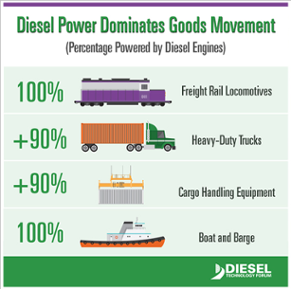What to Know About Clean Diesel Engines

Did you know that 33% of all medium and heavy duty commercial trucks on U.S. highways–or 2.9 million out of 8.8 million vehicles–are now outfitted with clean diesel engines?
For heavy duty trucks, more than 95% are equipped with clean diesel engines.
You’re probably thinking the same thing as we are: those are pretty impressive numbers! But what is clean diesel, exactly?
Clean diesel fuel contains 97% less sulphur than previous blends and immediately cuts soot emissions for any vehicle by 10%. Then, when you combine clean diesel fuel with advanced clean diesel engines and exhaust treatments, ultra-low sulfur diesel (ULSD) can reduce emissions by 95%.
Clean diesel engines showcase the latest technologies, such as electronic controls, high pressure and variable fuel injection, improved combustion chamber configuration, and turbochargers, while clean diesel exhaust tech advancements include particulate filters and oxidation catalysts.
This large swath of trucks now running on clean diesel engines are in part a response to a law that mandated that beginning in 2007, all heavy duty diesel trucks sold had to meet new emission standards: no more than 0.01 grams per brake horse-power hour (g/HP-hr).
And guess what? These new trucks did more than just meet the new standards–they surpassed them.
A 2013 study by the Coordinating Research Council and the Health Effects Institute found that the new generation of clean diesel engines manufactured starting in 2010 saw a reduction in emissions that exceeded the amount required by law.
Of the study, Allen Schaeffer, the executive director of the Diesel Technology Forum, said “Not only are the 2010 and later model year technology near zero emissions for fine particles, this study confirms that they are also substantially below the EPA/CARB standard for one of the key precursors to ozone formation (nitrogen dioxide)”.
On January 1st of this year, 2014, heavy-duty engine and truck manufacturers started offering new models that comply with more recent standards put forth by the EPA and National Highway Traffic Safety Administration. The new standards were instituted in order to lower emissions of carbon dioxide, and set minimum fuel economy levels between the years of 2014 and 2018.
These new trucks are going to havedrastic effectson the industry and the environment:they will reduce oil consumption by more than 500 million barrels, produce more than $50 billion in net benefits, and reduce carbon dioxide emissions by 250 million metric tons.
“Diesel trucks are literally the driving force behind goods movement in the U.S. and worldwide economies, so the fact that the clean diesel fleet is increasing is good news for improved fuel efficiency and the environment,” said Schaeffer.
Maybe you’re not ready to jump on the clean diesel bandwagon yet. Maybe you’re still worried about the cost of maintaining a truck that runs on clean diesel. However, we’re convinced that it’s the way to go. In case you need some more convincing, here are some of the benefits of clean diesel engines:
- Excellent fuel economy:Heavy-duty tractor trailer trucks consume 22 billion gallons of diesel fuel every year.That’s a lot of fuel!Clean diesel engines can drastically minimize fuel consumption. For example, from 2010-2012, the newer model, fuel-efficient heavy duty diesel trucks saved13.3 million barrels and 560 million gallons nationwide. And the newest models are expected to save even more: the new trucks manufactured in 2014 will improve fuel economy for your average long haul tractor by 20% by 2018, so there’s a lot of room for savings.
- A healthier environment: Cleaner diesel technologies significantly reduce emissions of smog-forming pollutants, particles, and heat-trapping gases, which means cleaner air for communities across the country.
- Energy Security:By embracing clean diesel technology, America reduces its reliance on foreign oil by reducing its overall oil consumption. If ⅓ of U.S. cars, pickup trucks, and SUVs were diesel-powered, we could save 1.4 million barrels of oil per day – an amount equivalent to the oil we import from Saudi Arabia. Now think how much we could save if all medium and heavy duty commercial trucks ran on clean diesel engines?
So how clean are these trucks?
Schaeffer explains, “These new trucks are so clean that it now takes more than 60 of today’s clean diesel trucks to equal the emissions from a single 1988 truck.” They are so clean, that if you hold a white handkerchief to the tailpipe of a vehicle outfitted with a new clean diesel engine, it’ll stay white. Pretty amazing, huh?
